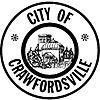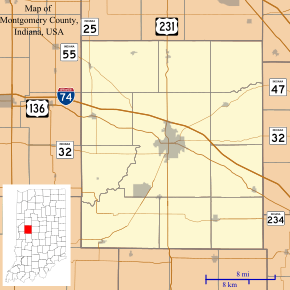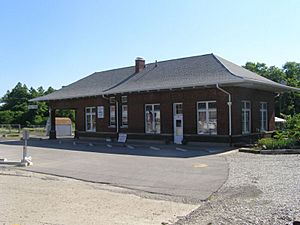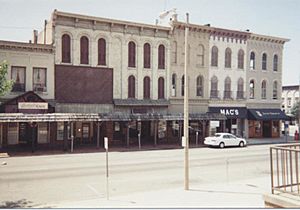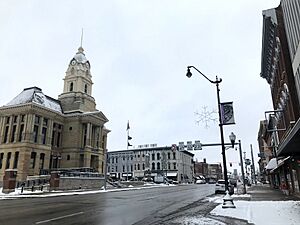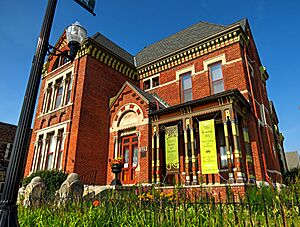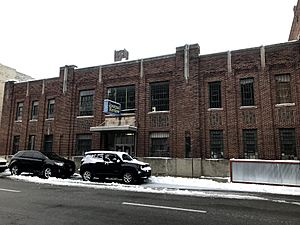Crawfordsville, Indiana facts for kids
Quick facts for kids
Crawfordsville, Indiana
|
||
|---|---|---|
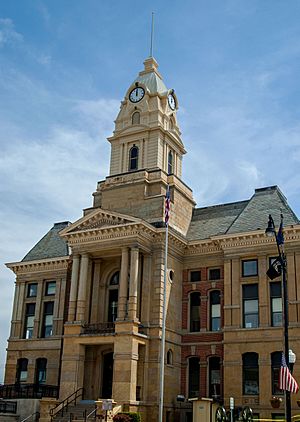
Montgomery County Courthouse in 2018
|
||
|
||
| Nickname(s):
"Athens of Indiana" (William Compton, 1825)
|
||
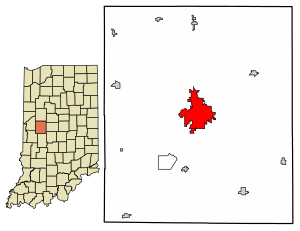
Location of Crawfordsville in Montgomery County, Indiana.
|
||
| Country | United States | |
| State | Indiana | |
| County | Montgomery | |
| Township | Union | |
| Area | ||
| • Total | 9.70 sq mi (25.11 km2) | |
| • Land | 9.70 sq mi (25.11 km2) | |
| • Water | 0.00 sq mi (0.00 km2) | |
| Elevation | 758 ft (231 m) | |
| Population
(2020)
|
||
| • Total | 16,306 | |
| • Density | 1,681.72/sq mi (649.30/km2) | |
| Time zone | UTC-5 (Eastern (EST)) | |
| • Summer (DST) | UTC-4 (EDT) | |
| ZIP codes |
47933-47939
|
|
| Area code(s) | 765 | |
| FIPS code | 18-15742 | |
| GNIS feature ID | 2393664 | |
| Website | crawfordsville.net | |
Crawfordsville is a city in Montgomery County, located in west-central Indiana, United States. It is about 49 miles (79 km) west-northwest of Indianapolis. In 2020, the city had a population of 16,306 people. Crawfordsville is the main city of the Crawfordsville, IN Micropolitan Statistical Area, which includes all of Montgomery County. It is also part of the larger Indianapolis–Carmel–Muncie, IN area.
The city was started in 1823 along Sugar Creek, a small river that flows into the Wabash River. It was named after William H. Crawford, who was the U.S. Treasury Secretary at the time. Crawfordsville is home to Wabash College, a private college for men, and the General Lew Wallace Study & Museum, which is a very important historical site.
Contents
History of Crawfordsville
How Crawfordsville Began
In 1813, some explorers thought the area where Crawfordsville is now would be a great place to live. It had lots of trees and good land for farming, plus water from a nearby creek. Ten years later, they found a cabin already built there! In 1823, Major Ambrose Whitlock planned out the town. He named it after William H. Crawford, who was the U.S. Treasury Secretary. Whitlock was the first person to settle in the town.
An early schoolmaster, Sanford C. Cox, wrote in his diary in 1824 that Crawfordsville was the only town between Terre Haute and Fort Wayne. It had a tavern, a small grocery store, and two other stores. The town officially became a town in 1834.
In 1832, Wabash College was founded in Crawfordsville. It started as a school for teachers but later became a general college. It is one of only three colleges in the country that are still just for men. About 900 students attend Wabash College.
In 1842, a 9-year-old boy named Horace Hovey found amazing Crinoid fossils along Sugar Creek. This discovery brought many researchers and fossil fans to the area. Crawfordsville grew, adding a bank and a fire department. It became a city in 1865.
Crawfordsville in the Late 1800s
Joseph F. Tuttle became president of Wabash College in 1862 and served for 30 years. He helped improve the relationship between the college and the town.
Many important generals from the American Civil War lived in Crawfordsville at different times. Generals Lew Wallace and Mahlon D. Manson lived most of their lives there. Other generals like Edward Canby and John P. Hawkins spent their youth in the city.
In 1880, Lew Wallace, a famous local citizen, wrote Crawfordsville's most well-known book, Ben-Hur: A Tale of the Christ. This historical novel is about the beginning of Christianity. Crawfordsville was known as "The Athens of Indiana" because many authors lived there, including Maurice Thompson and Meredith Nicholson.
Many people believed the first basketball game in Indiana happened in Crawfordsville in 1894. While Crawfordsville was one of the first places to play basketball in Indiana, it wasn't the very first. However, basketball was very popular there early on. Teams from the local YMCA, Wabash College, and the high school played against each other. One of the earliest college basketball games, between Wabash College and Purdue University, also happened in Crawfordsville in 1894.
In 1882, one of the first rotary jails in the country opened in Crawfordsville. This unique jail rotated its cells. It was used until 1972 and is now a museum called the Montgomery County Jail and Sheriff's Residence. It is listed on the National Register of Historic Places.
Crawfordsville in the 1900s
The early 1900s brought important changes to Crawfordsville. Culver Union Hospital and the Carnegie Library were built in 1902. The hospital later moved and changed its name to Franciscan St. Elizabeth Health - Crawfordsville. In 1911, Crawfordsville High School was founded and won the state's first high school basketball championship!
For much of the 20th century, a large printing company called RR Donnelley was a major employer in Crawfordsville. Other companies like Nucor Steel, CSI Closures, Raybestos Products Company, Pace Dairy Foods, and Random House also built factories nearby, providing many jobs.
Wabash College won the Division III NCAA basketball title in 1982. The college also plays an annual football game against Depauw University for the Monon Bell, which is one of the oldest rivalries in college sports.
Crawfordsville in the 2000s
In 2005, the Crawfordsville District Public Library moved into a new building. The old Carnegie library building became the Carnegie Museum of Montgomery County in 2007.
In 2007, a large fire destroyed some historic buildings downtown. Sadly, one person passed away in the fire. In 2015, Crawfordsville received a special "Stellar Community" grant from Indiana, which helps improve communities.
In 2018, a new clock tower was placed on the courthouse. The original clock tower had been removed in 1941. This new tower was built thanks to many years of fundraising by a local committee.
Historic Places in Crawfordsville
As of 2016, Crawfordsville has twelve properties listed on the National Register of Historic Places. These are important historical sites. Three of them are museums: the Gen. Lew Wallace Study, the Henry S. Lane House, and the Montgomery County Jail and Sheriff's Residence (the old rotary jail). Two are historic districts: the Crawfordsville Commercial Historic District and the Elston Grove Historic District.
Geography of Crawfordsville
Crawfordsville is located in west-central Indiana. It covers about 9.15 square miles (23.7 square kilometers) of land. The city is about an hour's drive west-northwest of Indianapolis, which is Indiana's capital. Crawfordsville is the main city of its own small metropolitan area, which is part of the larger Indianapolis–Carmel–Muncie, IN Combined Statistical Area.
Population Information
| Historical population | |||
|---|---|---|---|
| Census | Pop. | %± | |
| 1840 | 1,327 | — | |
| 1850 | 1,513 | 14.0% | |
| 1860 | 1,922 | 27.0% | |
| 1870 | 3,701 | 92.6% | |
| 1880 | 5,251 | 41.9% | |
| 1890 | 6,089 | 16.0% | |
| 1900 | 6,649 | 9.2% | |
| 1910 | 9,371 | 40.9% | |
| 1920 | 10,139 | 8.2% | |
| 1930 | 10,355 | 2.1% | |
| 1940 | 11,089 | 7.1% | |
| 1950 | 12,851 | 15.9% | |
| 1960 | 14,231 | 10.7% | |
| 1970 | 13,842 | −2.7% | |
| 1980 | 13,325 | −3.7% | |
| 1990 | 13,584 | 1.9% | |
| 2000 | 15,243 | 12.2% | |
| 2010 | 15,915 | 4.4% | |
| 2020 | 16,306 | 2.5% | |
| U.S. Decennial Census | |||
Crawfordsville's Population in 2010
In 2010, there were 15,915 people living in Crawfordsville. There were 6,396 households, and 3,837 families. The city had about 1,739 people per square mile (671 people per square kilometer). Most of the people (92.1%) were White. About 1.7% were African American, and 0.9% were Asian. About 8.2% of the population was Hispanic or Latino.
About 30.3% of households had children under 18 living with them. The average age in the city was 36.6 years old. About 22.3% of residents were under 18, and 16.9% were 65 or older.
Economy and Jobs
Crawfordsville is home to the world's first "thin-slab casting minimill" for steel. This means Nucor Steel recycles scrap steel using a special electric furnace. They started their facility in Crawfordsville in 1987.
R.R. Donnelley & Sons Company, a large printing plant, also started in Crawfordsville in 1921. It still provides many jobs for local residents. The plant is now called Lakeside Book Company.
Education in Crawfordsville
Most of the city is served by the Crawfordsville Community Schools district. Some parts of northern Crawfordsville are in the North Montgomery Community School Corporation, and small parts of southern Crawfordsville are in the South Montgomery Community School Corporation.
Colleges and Universities
- Wabash College
- Ivy Tech Community College (Crawfordsville campus)
Local Media
Crawfordsville is one of the smallest cities in the United States to have two daily newspapers: The Paper and the Journal Review.
Transportation
Highways
 Interstate 74 connects to Danville, Illinois and Indianapolis.
Interstate 74 connects to Danville, Illinois and Indianapolis. U.S. Route 136 also goes to Danville, Illinois and Indianapolis.
U.S. Route 136 also goes to Danville, Illinois and Indianapolis. U.S. Route 231 connects to Lafayette and Greencastle.
U.S. Route 231 connects to Lafayette and Greencastle. State Road 32 goes to Perrysville and Lebanon.
State Road 32 goes to Perrysville and Lebanon. State Road 47 connects to Sheridan and Waveland.
State Road 47 connects to Sheridan and Waveland.
Train Service
Crawfordsville used to have passenger train service from the Monon Railroad until 1967. Now, Amtrak's Cardinal train stops in Crawfordsville three times a week. This train travels between New York and Chicago.
Airport
Crawfordsville has its own airport, the Crawfordsville Regional Airport (KCFJ). It is located about 4 miles (6.4 km) south of the city. The airport is mainly used for general aviation, which means smaller private planes. It has one asphalt runway that is 5,505 feet (1,678 meters) long.
Famous People from Crawfordsville
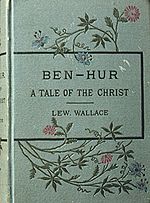
Many notable people have connections to Crawfordsville:
- Joseph P. Allen – An astronaut who was a mission specialist on the first fully working Space Shuttle flight in 1982.
- Richard Elwell (R.E.) Banta – A writer and rare book dealer.
- Edward Richard Sprigg Canby – A Union general during the Civil War who attended Wabash College.
- Henry Beebee Carrington – A Union general during the Civil War.
- Joseph Stephen Crane – A restaurateur and actor.
- Sidney and Wilbur de Paris – Brothers who were jazz musicians.
- Beatrice Schenk de Regniers – An author of children's books.
- Dick Dietz – A professional baseball player.
- Leroy Edwards – A professional basketball player in the 1940s.
- Isaac Compton Elston Sr. – A land investor and banker.
- Dave Gerard – A cartoonist who also served as Crawfordsville's mayor.
- Elizabeth Boynton Harbert – A 19th-century author and reformer, born and raised in Crawfordsville.
- John Parker Hawkins – A career Army officer who became a Union general during the Civil War.
- Bill Holman – A cartoonist who created Smokey Stover.
- Kent Kessler – An avant-garde jazz bassist.
- Caroline Virginia Krout – An author.
- Mary Hannah Krout – A journalist and author.
- Eleanor Lambert – A leader in the NYC fashion industry.
- Janet Lambert – An author of young adult fiction.
- Ward Lambert – Purdue University's basketball coach and a member of the Naismith Basketball Hall of Fame.
- Henry S. Lane – A United States Senator and Governor of Indiana.
- Stephen A. Love – A musician.
- Mahlon D. Manson – A Union Army general and Indiana Lieutenant Governor.
- James W. Marshall – The gold miner who helped start the California Gold Rush.
- Joseph E. McDonald – A lawyer and U.S. Senator.
- Caleb Mills – An author who helped create free schools in Indiana.
- James Atwell Mount – Governor of Indiana from 1897 to 1901.
- Kenyon Nicholson – A playwright and screenwriter.
- Meredith Nicholson – An author, politician, and diplomat.
- Allen Saunders – A cartoonist who wrote Steve Roper and Mary Worth.
- Will Shortz – The New York Times puzzle writer.
- Lee Orean Smith – A composer and music teacher.
- Maurice Thompson – An author, poet, and naturalist.
- Dick Van Dyke – A famous actor who briefly attended Tuttle Middle School in Crawfordsville.
- Lew Wallace – A Union general in the Civil War and the author of Ben-Hur. He also served as Governor of New Mexico Territory.
- Susan Wallace – An author and poet, and wife of Lew Wallace.
- Maurine Dallas Watkins – The author of Chicago and a Hollywood screenwriter.
- Howdy Wilcox – An Indianapolis 500 racing pioneer who won the 1919 Indy 500.
- Henry Lane Wilson – A U.S. diplomat and Ambassador to Mexico.
- Jacob Wilson – A racing driver.
- James Wilson – A politician and U.S. Ambassador to Venezuela.
- John L. Wilson – A politician and U.S. Senator from Washington.
See also
 In Spanish: Crawfordsville (Indiana) para niños
In Spanish: Crawfordsville (Indiana) para niños


